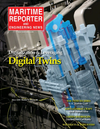
Page 25: of Maritime Reporter Magazine (June 2024)
Read this page in Pdf, Flash or Html5 edition of June 2024 Maritime Reporter Magazine
DIGITAL TWINS “We build systems that try to reduce ce hat the cognitive burden of the people that are operating the system.”
Trey Taylor, Director of Digital Innovation,
Fairbanks Morse Defense (FMD)
Here’s where it is. Go take a look. We have access to the data tive longer, spending less on spares, spending less on repair, if the Navy wants to provide it, so then our technical team can and being able to have more hours on these engines at sea.” come right behind the Navy’s organic capability and provide The U.S. Navy is a different story.
our OEM insights into plant health.” “In the Navy, they’re slow bandwidth; they’re highly secure
Taylor believes that driving action is the core value of digi- networks; they don’t want to have signals going 24/7/365 off tal twin technology. “I believe the outcome of digital twins that vessel because it gives away location data. We build our that everyone’s looking for is action. The data is important to digital twins for the Navy to be 100% on-premises, meaning drive actions, but that’s where the hole in the system is today. they run on the ship. They don’t have to touch back to the in-
It doesn’t tell the sailor to go do something. It says, “Here’s ternet at all to get any of the services working. And then we’ve the big picture.” But it doesn’t tell them: “Here’s where you’re built a facility that, if there is a path back to NAVSEA or to going to go. Here’s where you need to ? x. Here’s where you Navy cyber ops that they can of? oad that data on their own. need to touch.” And that’s what the customer wants. They They don’t need Fairbanks to pull it.” want the ability to easily drive preventative maintenance or Ultimately, FMD aims to create platforms that are generic responsive action to change of capital assets.” so that other OEs can interface with it: “we’re not trying to
The cost saving has multiple potential tendrils, from head- create silos, we’re trying to create platforms as opposed to a ing off problems before they create bigger problems, but also “Fairbanks exclusive,” said Taylor. in delivering real condition-based monitoring that could allow While there is economy in scale in rolling out digital twin the extension of traditional time-based maintenance items. technology to multiple engines, vessels and ? eets, Taylor “If they can assess the equipment and see that the equipment doesn’t see the tech as a necessity for every single product is still healthy and stable, they may be able to push something and system on the ship.
like a spare part change every 5,000 hours to maybe every “I think the high-cost, high-value capital equipment that’s 8,000 hours. That has a substantial cost bene? t over the life of going to cost you the most to maintain, or is a safety require- these vessels, especially for the U.S. Navy.” ment for that ship to sail, are the kind of systems you want [in
Finally, the digital twin’s ability to maintain and catalog his- the digital twin].” torical data is invaluable for future planning. “The Navy keeps Typically, for me, I can deploy [digital twin on] an en- good records, but they’re a bit obtuse, [and it can be] hard gine today for about $60,000. That’s with all the hardware, to get to the meat of what happened and why. With a digital all the setup, the con? guration. That’s what it takes for me twin, that data’s there forever,” and can be leveraged to avoid to build one,” said Taylor. In manufacturing scale delivers similar problems in the future. costs savings, and the same can be said for digital twins: as the number of similar engines on a ? eet goes up, the time
Enabling Engineering Support to build and connect them via digital twin goes down. “The
In the commercial space, digital twins are limited only by economics get better if I have a four-engine ship, or 16 ships the availability and use of bandwidth which effectively links with four engines apiece; the economics get stronger every ship to shore, and as multiple new satellite systems emerge vessel that I deploy on.” While FMD has been on the digital and the cost of bandwidth falls, additional real-time bene? ts twin journey for more than three years, Taylor said that in and opportunities emerge. some respects, you’re always at the beginning “because the “The big liners are already running digital twins in real time technology’s changing, it gets better. From our perspective, on their ships. And they’re doing it under active management. the platform will never be done, [because we will constantly
Meaning, there’s someone that’s monitoring these ships pretty evolve new features, new technologies that become avail- much 365 days a year. The big companies are recognizing able, faster, cheaper technologies for doing analysis of data, good economic bene? ts from doing this, keeping the ships ac- for example. This is a constant evolution.” www.marinelink.com 25
MR #6 (18-33).indd 25 6/3/2024 12:07:57 PM

 24
24

 26
26
